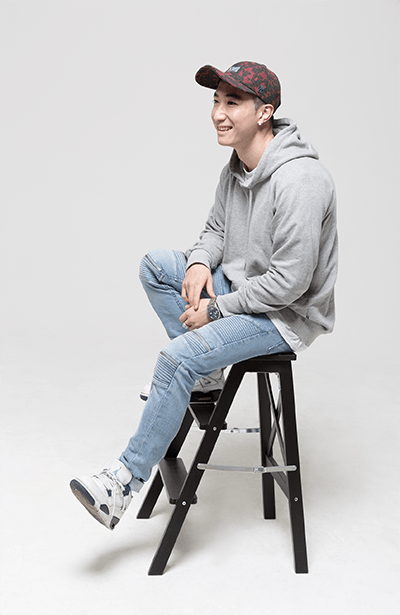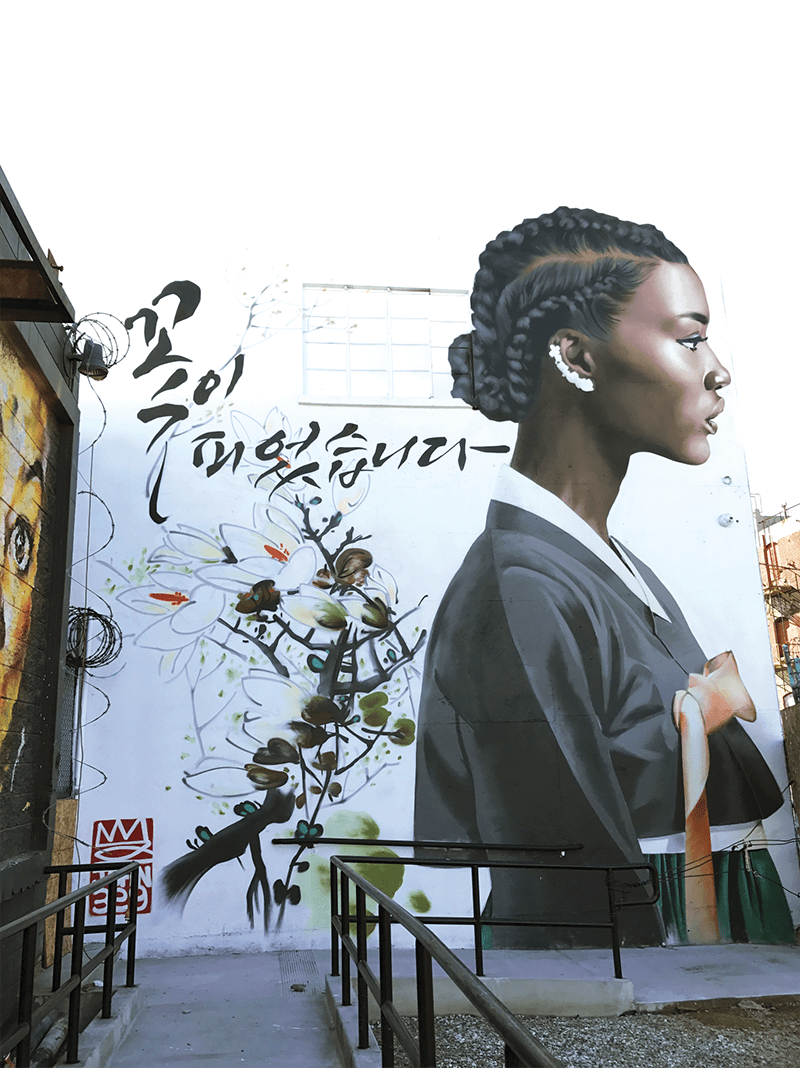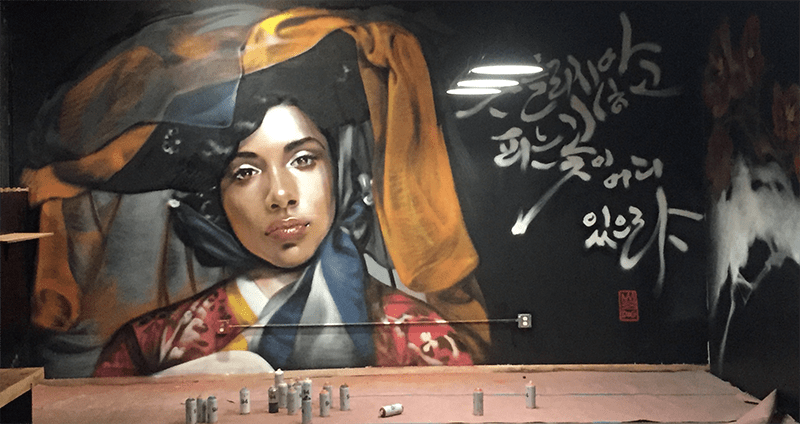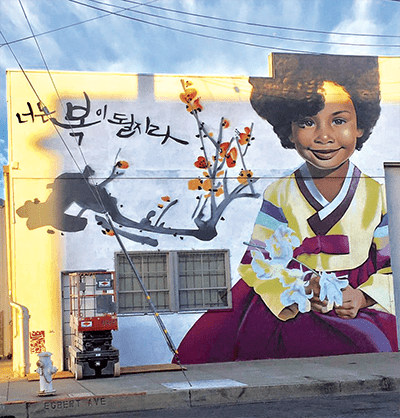“We are all doing the same thing, enhancing African American images,”
says Chanyang Shim, who became known for a graffiti artwork depicting an African American wearing a Hanbok.
says Chanyang Shim, who became known for a graffiti artwork depicting an African American wearing a Hanbok.

A Korean hip-hop artist made global fame with a graffiti art piece depicting an African American female wearing a hanbok. The artwork was praised for making a peace offering for the world culturally divided into the Western and the Eastern culture. The graffiti artist’s name is Chanyang Shim (31), and he set himself up as working in the African American beauty industry. He was given a global spotlight for his graffiti works illustrating African American models during his short visit to the U.S. with little plan. In the beginning of his graffiti career, he barely made a living, but now he is extremely busy due to the flood of artwork requests. BNB made it through his busy schedules for an interview about his past, present, and future plans.
(BNB) When and how were you first introduced to graffiti?
(Shim) I started drawing graffiti when I was a high school senior. Growing up, I was interested in African American culture, especially hip-hop. Graffiti is one of the four major elements of hip-hop culture along with music, B-boying, and DJ-ing. I think I became interested in African-American culture partly because of my family. My father and grandfather were pastors, who always kept their eyes on African missions. We always had a bread-shaped money jar for donations that would go to help African kids. As I grew up in that kind of environment, Africans did not feel like strangers but like brothers. At first, I would scribble some graffiti works on walls and run away. As a youngster, I once got caught by a police officer drawing graffiti on the wall of a police station.
I majored cartoon art in college after graduating an arts high school. After serving in the military, I went to Philippines to study theology in an attempt to pursue my career as a missionary to Africa. After spending two years in Philippines, I flew to Australia to become a professional graffiti artist. Two years in Australia was economically hard for me. Nevertheless, the time I spent with fellow graffiti artists was priceless. My Australian working holiday visa was to expire in two years, so I came back to South Korea. A year after coming back to South Korea, I decided to try my luck at the capital of graffiti and also of hip-hop culture, America. I came here with a temporary status under a U.S. visa waiver program, so I had three months. For the short time period, I was very lucky to become famous.

(BNB) How did you become so famous within the three-month period under a visa waiver program?
(Shim) I drew nonstop in New York, Los Angeles, and San Francisco for three months. Although my two years in Australia was tough, the people I met there led me to a chance to work with a graffiti group in America. My time in Perth, Australia was not fruitless as it paved my career path in America. I joined a graffiti crew in Bronx, New York, where I got paid for the first time for my artwork. Spending two busy months in New York, I flew to LA. With my friend’s endorsement, I was given an interior wall of Street Art Gallery in LA for my artwork. On that wall, I drew the piece, “Every flower should be shaken before coming out.” That work was well received by the audience, and I could work on a larger piece on an exterior wall soon after. That wall gave the birth to the work called “Flower came out,” featuring an African American girl wearing a hanbok in black color. Lastly, right before my comeback to home, I left a piece of artwork on the exterior wall of a factory in San Francisco. I adorned an African American girl with a hanbok in bright colors and wrote “You will be blessing.” This artwork was well received by American media who said the drawing brightened up the sketchy neighborhood. Since then, many South Korean and American media covered my artwork, and I became well known to the general public over a night.

(BNB) They say African Americans love your work…
(Shim) As it became a hot topic in South Korea, many K-pop followers in African American community noticed my work. As they love Korean culture by default, it would be only natural that they get emotional and passionate about an African American individual wearing a hanbok. My artwork is located in a community with a large African American population, so I received many messages via social media who self-reported that they burst into tears after seeing the drawing. I did not understand at first. What is it that brings them into tears about the drawing? I had chances to learn more about their stories, and many of them were people who were hurt by Koreans, who hate Koreans, or who were treated badly while working for a Korean business owner. When they saw the drawing, they felt like it was a peace offering.
(BNB) Were there any special thought given to the illustration of an African American individual wearing a hanbok?
(Shim) Personally, I love hip-hop, and graffiti is part of hip-hop culture. So, I wanted to impersonate African Americans who are the epic center of the culture. As the hip-hop culture was brought about by African Americans, it is a sure thing that I wanted their attention. Even I was in South Korea, I always thought I should draw African Americans to get it right. That is why I started to draw African Americans, and for my beloved African American friends, I came up within an idea of adorning our hanbok on them. My original intent was like that, and it was interpreted favorably by many. Since then, I felt it would be my responsibility to keep working on the theme.

To be continued…
The Story Graffiti Artist Interview BY SAMUEL BEOM
BNB Magazine JAN 2020 ©bnbmag.com
ABOUT US / SUBSCRIBE / ADVERTISE WITH US / PARTICIPATION / CONTACT /